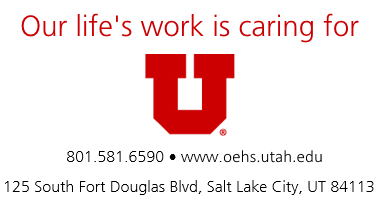ONLY CLEAN WATER CAN GO DOWN THE STORM DRAIN ON CAMPUS
In urban areas, like the university, where there are mostly parking lots, sidewalks, paved streets and rooftops, less rainfall can soak directly into the ground. The runoff is carried by curbs or gutters into storm drains or spillways. Storm drains are separate from the sanitary sewer and DO NOT lead to a treatment plant. The storm water runoff is ultimately deposited in our washes, rivers or lakes without being treated.
As such, it is part of the University Stormwater Management Plan the University of Utah prohibits the commencement, conduct or continuance of any illegal, non-storm water discharge to the storm drain system. Illicit discharges are generally any spill into a storm drain system this is not composed entirely of storm water. Pollutants include, but are not limited to the following:
- Oil or other fluids from motor vehicles.
- Pet waste
- Trash, litter or debris such as grass clippings
- Household hazardous wastes (kitchen and bathroom cleaners, etc.)
- Construction site generated pollutants (concrete washout, sediment)
Preventing illicit discharges and storm water pollution is everyone’s responsibility whether at home or while in the workplace:
- Conduct vehicle maintenance in a proper place, not in a parking lot.
- Clean up drips and leaks promptly.
- Keep in mind that all oils, including edible oils, are an environmental hazard.
- Tightly close containers when you are not using them
- Store oil containers inside secondary containment. If you store several containers of oil, provide enough containment for at least one entire container.
- Store containers out of the flow of traffic.
- Make everyone in the area aware of what is stored and how to respond.
- Have a spill response kit available in the event of an accident.
For Information about household hazardous waste or to find proper disposal locations, click here.
For more information visit us at oehs.utah.edu, or if you observe illegal dumping, construction site sediment tracking, or spilled materials threatening storm drains at the university please contact Occupational and Environmental Health and Safety by email or at 801-581-6590.

